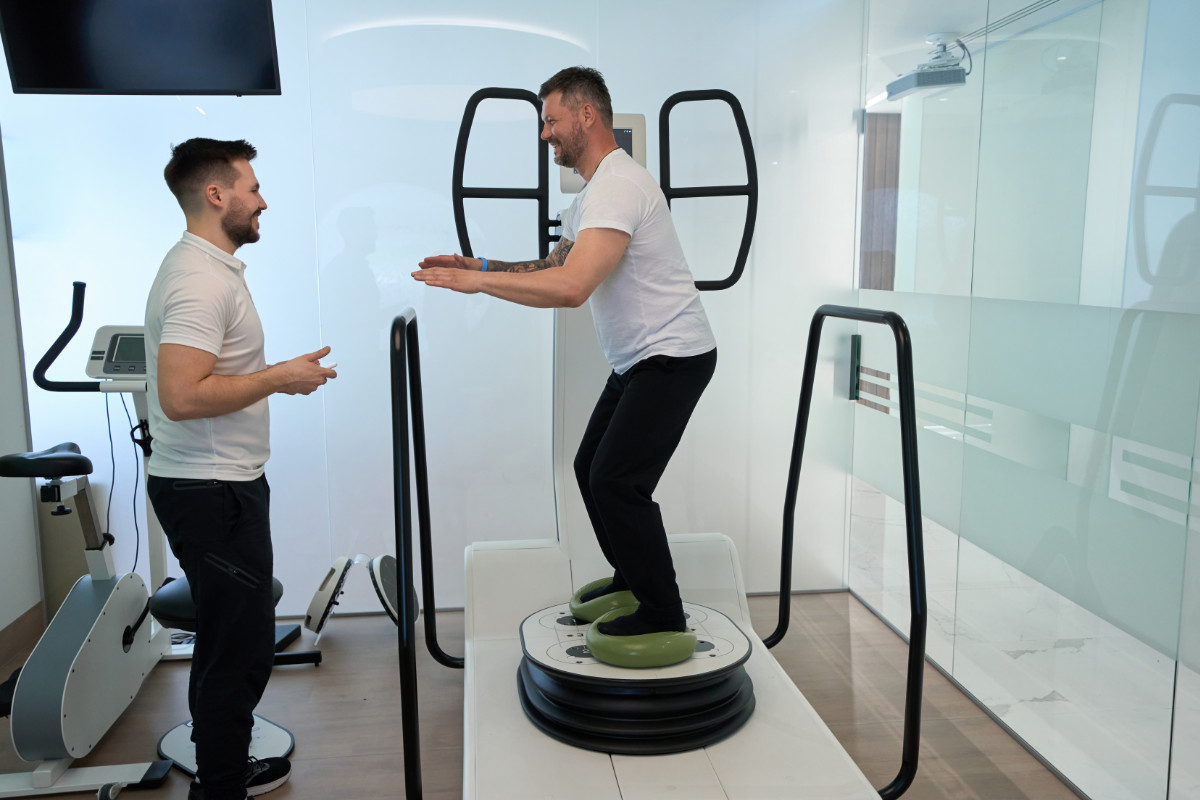If you’ve been scrolling through fitness content lately, you might have seen people talking about the 3-3-3 rule at the gym. This straightforward approach to strength training has gained popularity because it takes the guesswork out of your workouts. The 3-3-3 rule gym method means doing 3 sets of 3 exercises for 3 major muscle groups in each session.
This method works because it keeps your workouts focused and manageable. Instead of spending hours at the gym doing endless exercises, you target specific muscle groups with just enough volume to see real results.
How Does the 3-3-3 Rule Actually Work?
The 3-3-3 rule breaks down like this:
3 muscle groups – You pick three major muscle groups to work on in one session. For example, chest, back, and legs.
3 exercises per group – For each muscle group, you choose three different exercises. This gives you variety without overwhelming your workout.
3 sets per exercise – You complete three sets of each exercise, which research shows is the sweet spot for muscle growth.
When you follow what is the 3-3-3 rule gym training, you end up doing 9 exercises total per workout with 27 sets. This takes most people between 45 to 60 minutes to complete, making it perfect for busy Australians who can’t spend two hours at the gym.
Why Do Personal Trainers Recommend This Method?
Personal trainers across Melbourne and Australia recommend the 3-3-3 rule because it delivers results without causing burnout. According to exercise science research, doing 10 to 20 sets per muscle group per week leads to nearly double the muscle gains compared to doing just 5 sets per week.
The 3-3-3 rule fits perfectly into this range. If you train each muscle group twice per week using this method, you hit 18 sets per muscle group weekly. This matches what the science says works best for building muscle and strength.
Professional trainers also like this method because it prevents the most common gym mistake: doing too much too soon. New gym-goers often try to copy advanced programs and end up exhausted or injured. The 3-3-3 rule gives you structure without overdoing it.
What Exercises Should You Include?
Your exercise selection matters. Here’s how to build an effective 3-3-3 workout:
For chest:
- Barbell bench press or dumbbell press
- Incline press (targets upper chest)
- Cable flyes or push-ups
For back:
- Pull-ups or lat pulldowns
- Barbell rows or dumbbell rows
- Face pulls or cable rows
For legs:
- Squats (barbell or goblet)
- Deadlifts or Romanian deadlifts
- Lunges or leg press
For shoulders:
- Overhead press (barbell or dumbbell)
- Lateral raises
- Front raises or rear delt flyes
For arms:
- Barbell curls
- Tricep dips or close-grip bench press
- Hammer curls and tricep extensions
Choose exercises that work multiple muscles at once for the first exercise in each group. These compound movements like squats, deadlifts, and bench press give you the most benefit. Then add isolation exercises that target specific muscles.
9 Steps To Shed 5–10kg in 6 Weeks
While spending as little as 90 minutes per week in the gym!
Includes an exercise plan, nutrition plan, and 20+ tips and tricks.
Without dead boring diets that are like watching paint dry
Without getting results at a snails pace
Gym or at home version
How Many Reps Should You Do Per Set?
The rep range depends on your goals:
For building muscle: Do 8 to 12 reps per set. This range creates enough tension in your muscles to trigger growth while letting you lift heavy enough weight to challenge yourself.
For building strength: Do 6 to 8 reps per set with heavier weights. Focus on increasing the weight you lift over time.
For muscular endurance: Do 12 to 15 reps per set with lighter weights. This works well if you play sports or want to improve your fitness for daily activities.
Most people see the best results sticking with 8 to 12 reps. This builds both size and strength without requiring you to lift extremely heavy weights that increase injury risk.
How Often Should You Train Using the 3-3-3 Rule?
Train 3 to 5 times per week for best results. Here’s how to split it up:
3 days per week:
- Day 1: Chest, shoulders, triceps
- Day 2: Back, biceps, abs
- Day 3: Legs, glutes, core
4 days per week:
- Day 1: Chest and triceps
- Day 2: Back and biceps
- Day 3: Legs and glutes
- Day 4: Shoulders and abs
5 days per week:
- Day 1: Chest
- Day 2: Back
- Day 3: Legs
- Day 4: Shoulders
- Day 5: Arms and abs
Research shows your muscles need 48 to 72 hours to recover after a hard workout. The 3-3-3 rule naturally builds in this recovery time because you’re not hitting the same muscles every day.
What Results Can You Expect?
When you follow the 3-3-3 rule consistently, you can expect to see changes within 4 to 6 weeks. Your strength will increase first. You’ll notice you can lift heavier weights or complete more reps with the same weight.
Muscle growth takes a bit longer. Most people start seeing visible muscle definition after 8 to 12 weeks of consistent training. This matches what exercise science tells us about how long it takes for your body to build new muscle tissue.
The key word here is consistent. Going to the gym once or twice and then stopping won’t give you results. You need to show up regularly and progressively challenge your muscles by adding weight or reps over time.
How Much Does It Cost to Follow This Program?
The beauty of the 3-3-3 rule is that it works with any budget:
Gym membership: Most gyms in Melbourne charge between $15 to $30 per week for basic access. Budget gyms like Jetts or Anytime Fitness cost around $15 to $20 weekly, while premium gyms charge $25 to $40 per week.
Home gym setup: If you prefer training at home, you can start with basic equipment for $300 to $800. This includes a set of dumbbells ($150 to $300), a bench ($100 to $200), and a pull-up bar ($50 to $100). You can add a barbell and weights later for another $300 to $500.
Personal trainer: If you want help learning proper form, expect to pay $60 to $120 per session in Melbourne. Many trainers offer package deals that bring the cost down to $50 to $80 per session.
You don’t need expensive equipment or supplements to make the 3-3-3 rule work. The basic gym equipment found in any fitness center is enough.
Common Mistakes to Avoid
Skipping warm-ups: Always spend 5 to 10 minutes warming up before lifting weights. This increases blood flow to your muscles and reduces injury risk.
Using too much weight: Your form matters more than the weight you lift. If you can’t complete a rep with proper technique, the weight is too heavy.
Not tracking progress: Write down what weights you use and how many reps you complete. This helps you progressively overload your muscles, which is essential for growth.
Ignoring rest days: Your muscles grow during rest, not during workouts. Take at least one or two complete rest days each week.
Rushing through sets: Take 60 to 90 seconds rest between sets. This gives your muscles enough recovery to perform well on the next set.
FAQ: Your 3-3-3 Rule Questions Answered
Can beginners use the 3-3-3 rule?
Yes. The 3-3-3 rule works perfectly for beginners because it provides structure without overwhelming you. Start with lighter weights and focus on learning proper form for each exercise. After 4 to 6 weeks, you’ll be ready to increase the weight.
How long should each workout take?
Plan for 45 to 60 minutes per session. This includes your warm-up, the 9 exercises with rest periods, and a brief cool-down. If you’re taking longer than 75 minutes, you’re probably resting too long between sets or getting distracted.
Should I do cardio with the 3-3-3 rule?
Yes, add 2 to 3 cardio sessions per week on your non-lifting days or after your strength workout. Walking for 30 minutes, cycling, or swimming all work well. Cardio improves your heart health and helps with fat loss without interfering with muscle growth.
What if I can’t do 3 sets of an exercise?
Start with 2 sets and build up to 3 sets over a few weeks. Your body needs time to adapt to new training stress. It’s better to do 2 quality sets than 3 poor sets where your form breaks down.
Do I need to take supplements?
No. Supplements aren’t required to see results from the 3-3-3 rule. Focus on eating enough protein (1.6 to 2.2 grams per kilogram of body weight daily), getting quality sleep, and training consistently. These basics matter far more than any supplement.
Can I modify the exercises?
Absolutely. If you have an injury or certain exercises cause pain, swap them for alternatives that work the same muscle group. For example, if barbell squats hurt your knees, try goblet squats or leg press instead.
How do I know if I’m lifting heavy enough?
The last 2 to 3 reps of each set should feel challenging. If you finish your set and feel like you could easily do 5 more reps, increase the weight next time. If you can’t complete at least 6 reps with good form, reduce the weight.
What should I eat before and after workouts?
Eat a meal with protein and carbs 1 to 2 hours before training. Good options include chicken with rice, eggs with toast, or Greek yogurt with fruit. After training, eat another protein and carb meal within 2 hours. Your muscles need this fuel to recover and grow.
The Bottom Line
The 3-3-3 rule gym method gives you a simple, effective framework for building muscle and strength. By focusing on 3 muscle groups, 3 exercises per group, and 3 sets per exercise, you get enough training volume to see results without spending hours in the gym or risking burnout.
This approach works for beginners who need structure and experienced lifters who want a straightforward program. The key is showing up consistently, progressively adding weight or reps, and giving your body time to adapt and grow.
Start with weights you can control with good form, track your progress, and trust the process. Within a few months, you’ll see real changes in your strength and physique.



